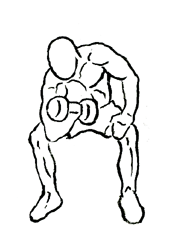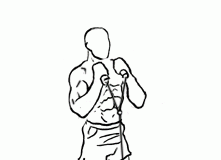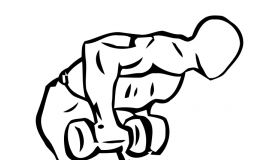Last Updated on October 8, 2023
When it comes to developing strong and defined biceps, concentration curls with dumbbells are a go-to exercise for fitness enthusiasts. This isolation exercise is designed to target the bicep muscles effectively, helping you achieve that coveted peak and muscular definition. In this comprehensive guide, we will explore the benefits of concentration curls, provide a detailed step-by-step guide on how to perform them correctly, discuss variations to keep your workouts exciting, and offer tips for maximizing your bicep gains.
What Are Concentration Curls?
Concentration curls are a type of bicep curl that focuses solely on the biceps by limiting movement in other parts of the body. By isolating the bicep muscles, concentration curls enable you to concentrate on proper form and execution, enhancing muscle engagement and effectiveness. The nature of this exercise makes it particularly valuable for those seeking to refine their bicep development and overall arm aesthetics.
Benefits of Concentration Curls
- Isolation of the Biceps: Concentration curls specifically target the biceps brachii, allowing for maximum muscle engagement. This isolation is crucial for building strength and size in your arms.
- Improved Muscle Definition: By focusing on the biceps, this exercise helps in achieving better muscle definition. Over time, you’ll notice increased muscle tone and a more sculpted appearance in your arms.
- Enhanced Mind-Muscle Connection: The concentrated movement of this exercise fosters a stronger mind-muscle connection, enabling you to focus on contracting and controlling the biceps throughout the entire range of motion.
- Corrects Muscle Imbalances: Concentration curls allow you to work each arm independently, which helps to identify and correct any muscle imbalances between the left and right biceps.
- Versatile Training: Concentration curls can be easily incorporated into various workout routines, whether you’re training for strength, hypertrophy, or endurance.
How to Perform Concentration Curls with Dumbbells
To reap the full benefits of concentration curls, it’s essential to execute them correctly. Here’s a step-by-step guide to performing this exercise:
Step 1: Get into Position
- Sit on a Bench: Start by sitting on the edge of a flat bench. Ensure your feet are flat on the floor and your legs are spread apart for stability.
- Grab a Dumbbell: With one hand, grasp a dumbbell using an underhand grip (palms facing up). Choose a weight that challenges you without compromising your form.
Step 2: Position Your Arm
- Rest Your Elbow: Press your elbow against the inside of your thigh. This position stabilizes your arm and limits movement, allowing for a more controlled curl.
- Maintain Posture: Keep your back straight, chest up, and shoulders relaxed. Avoid leaning back or using momentum to lift the weight.
Step 3: Curl the Dumbbell
- Lift the Dumbbell: Begin the curl by flexing your elbow, bringing the dumbbell up towards your shoulder. Focus on squeezing your bicep at the top of the movement for maximum contraction.
- Control the Motion: Keep the movement slow and controlled. Avoid swinging the dumbbell or using your body to lift it. This is all about isolating the bicep.
Step 4: Return to the Starting Position
- Lower the Dumbbell: After reaching the peak of the curl, slowly lower the dumbbell back to the starting position. Control the descent to maximize muscle engagement and avoid injury.
- Focus on Form: Ensure that your elbow remains pressed against your thigh throughout the movement. Your body should stay still except for the arm performing the exercise.
Step 5: Switch Arms
- Repeat: After completing your desired repetitions on one arm, switch to the other arm and repeat the process.
- Repetitions and Sets: Aim for 8 to 12 repetitions per arm for 2 to 4 sets, depending on your fitness level and goals.
Tips for Effective Concentration Curls
- Choose the Right Weight: Select a dumbbell weight that allows you to perform the exercise with proper form. It’s better to start lighter and focus on technique rather than lifting too heavy and risking injury.
- Engage Your Core: While the focus is on the biceps, engaging your core during the exercise helps maintain stability and good posture.
- Breathe Properly: Inhale as you lower the dumbbell and exhale as you curl it up. Proper breathing supports muscle function and helps you maintain rhythm throughout the exercise.
- Avoid Cheating: Resist the temptation to use momentum or body sway. Keep your movements controlled to ensure maximum muscle engagement.
- Track Your Progress: Keep a record of your sets, repetitions, and weights used. Tracking your progress helps you stay motivated and make adjustments to your routine as needed.
Variations of Concentration Curls
To prevent workout monotony and continue challenging your biceps, consider these variations of concentration curls:
- Seated Concentration Curls: Perform the exercise while sitting on a stability ball instead of a bench. This engages your core more and adds an element of instability.
- Standing Concentration Curls: Instead of sitting, try performing concentration curls while standing. This requires more stability and engages your core.
- Incline Concentration Curls: Use an incline bench to perform the curls. This changes the angle of resistance, providing a unique challenge to the biceps.
- Hammer Concentration Curls: Hold the dumbbell with a neutral grip (palms facing each other) instead of the traditional underhand grip. This variation targets the brachialis and brachioradialis, muscles that assist the biceps.
- Resistance Band Concentration Curls: Use a resistance band instead of a dumbbell for concentration curls. This adds a different type of resistance, which can be beneficial for muscle growth.
Incorporating Concentration Curls into Your Workout Routine
To effectively integrate concentration curls into your training regimen, consider the following guidelines:
- Frequency: Aim to perform concentration curls 1 to 2 times per week as part of your arm or upper body workouts. This frequency allows for adequate recovery while promoting muscle growth.
- Combine with Other Exercises: Pair concentration curls with other bicep exercises such as barbell curls, hammer curls, and preacher curls for a comprehensive arm workout.
- Progressive Overload: As you build strength, gradually increase the weight or the number of repetitions you perform. This principle of progressive overload is essential for continued muscle growth.
- Rest and Recovery: Allow your muscles time to recover between workouts. Adequate rest is crucial for muscle repair and growth.
Common Mistakes to Avoid
While concentration curls are relatively straightforward, there are some common mistakes to watch out for:
- Using Excessive Weight: Lifting too heavy can compromise your form and lead to injury. Always prioritize proper technique over the amount of weight lifted.
- Allowing Elbows to Move: Ensure that your elbows stay pressed against your thigh throughout the movement. This maintains the isolation of the biceps and maximizes the effectiveness of the exercise.
- Swinging the Dumbbell: Avoid using momentum to lift the weight. Focus on controlled movements to engage the biceps fully.
- Neglecting the Opposite Arm: Be sure to give equal attention to both arms. Neglecting one arm can lead to muscle imbalances over time.
- Rushing Through Reps: Take your time with each repetition. Rushing can lead to poor form and reduced muscle engagement.
Concentration curls with dumbbells are an effective exercise for building and defining bicep muscles. By isolating the biceps, this exercise allows for improved strength, muscle definition, and enhanced mind-muscle connection. With proper form, consistent practice, and a few variations, you can incorporate concentration curls into your fitness routine for optimal results.
Remember to start with a weight that suits your current strength level, focus on controlled movements, and track your progress. As you become more comfortable with the exercise, explore different variations to keep your workouts fresh and challenging. By following these guidelines, you’ll be well on your way to achieving stronger, more defined arms. Happy lifting!








